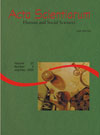<b>Medicinal plants: ethnobotanic study of Toledo districts and organization of a didactic material for science teaching</b> - DOI: 10.4025/actascihumansoc.v29i2.920
Abstract
The use of plants as medicine is part of the popular culture, and is important because it is an alternative medicine of low cost. However, the popular knowledge is been losing throughout the time. In such a way, the goal of this work is to rescue the popular knowledge on medicinal plants and to elaborate a didactic material that could be used in schools as didactic support. An ethnobotanic study of the medicinal plants used by the population of the districts of Toledo (PR) was carried out applying a questionnaire to 339 students of 3rd and 4th grades of basic education, and the collection of 1,539 plants whose classification resulted in 146 different species. The organization of the didactic material involved some concepts of Chemistry, Biology and Mathematics, and approached the procedures that must be taken into consideration when making use of medicinal plants and toxic plants.Downloads
Download data is not yet available.
Published
2008-02-25
How to Cite
Olguin, C. de F. A., Cunha, M. B. da, Bosco, C. B. D., Schneider, M. B., & Bocardi, J. M. B. (2008). <b>Medicinal plants: ethnobotanic study of Toledo districts and organization of a didactic material for science teaching</b> - DOI: 10.4025/actascihumansoc.v29i2.920. Acta Scientiarum. Human and Social Sciences, 29(2), 205-209. https://doi.org/10.4025/actascihumansoc.v29i2.920
Issue
Section
Education
DECLARATION OF ORIGINALITY AND COPYRIGHTS
I Declare that current article is original and has not been submitted for publication, in part or in whole, to any other national or international journal.
The copyrights belong exclusively to the authors. Published content is licensed under Creative Commons Attribution 4.0 (CC BY 4.0) guidelines, which allows sharing (copy and distribution of the material in any medium or format) and adaptation (remix, transform, and build upon the material) for any purpose, even commercially, under the terms of attribution.
Read this link for further information on how to use CC BY 4.0 properly.























